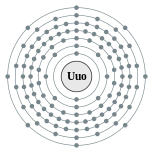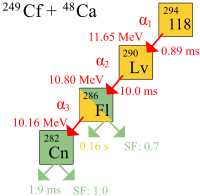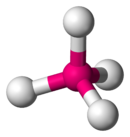
Ununoctium
Background Information
This selection is made for schools by a children's charity read more. SOS Children is the world's largest charity giving orphaned and abandoned children the chance of family life.
| Ununoctium | ||||||||||||||||
|---|---|---|---|---|---|---|---|---|---|---|---|---|---|---|---|---|
|
118Uuo
|
||||||||||||||||
|
||||||||||||||||
| Appearance | ||||||||||||||||
| unknown | ||||||||||||||||
| General properties | ||||||||||||||||
| Name, symbol, number | ununoctium, Uuo, 118 | |||||||||||||||
| Pronunciation | / uː n . uː n ˈ ɒ k t i ə m / oon-oon-OK-tee-əm |
|||||||||||||||
| Metallic category | unknown | |||||||||||||||
| Group, period, block | 18 (noble gases), 7, p | |||||||||||||||
| Standard atomic weight | [294] | |||||||||||||||
| Electron configuration | [Rn] 5f14 6d10 7s2 7p6 (predicted) 2, 8, 18, 32, 32, 18, 8 (predicted) |
|||||||||||||||
| History | ||||||||||||||||
| Discovery | Joint Institute for Nuclear Research and Lawrence Livermore National Laboratory (2002) | |||||||||||||||
| Physical properties | ||||||||||||||||
| Phase | solid (predicted) | |||||||||||||||
| Density (near r.t.) | (predicted) 13.65 g·cm−3 | |||||||||||||||
| Boiling point | (extrapolated) 350±30 K, 80±30 °C, 170±50 °F | |||||||||||||||
| Critical point | (extrapolated) 439 K, 6.8 MPa | |||||||||||||||
| Heat of fusion | (extrapolated) 23.5 kJ·mol−1 | |||||||||||||||
| Heat of vaporization | (extrapolated) 19.4 kJ·mol−1 | |||||||||||||||
| Atomic properties | ||||||||||||||||
| Oxidation states | (predicted) −1, 0, +1, +2, +4, +6 | |||||||||||||||
| Ionization energies | 1st: (extrapolated) 839.4 kJ·mol−1 | |||||||||||||||
| 2nd: (extrapolated) 1450 kJ·mol−1 | ||||||||||||||||
| Atomic radius | (predicted) 152 pm | |||||||||||||||
| Covalent radius | (predicted) 157 pm | |||||||||||||||
| Miscellanea | ||||||||||||||||
| CAS registry number | 54144-19-3 | |||||||||||||||
| Most stable isotopes | ||||||||||||||||
| Main article: Isotopes of ununoctium | ||||||||||||||||
|
||||||||||||||||
Ununoctium is the temporary IUPAC name for the transactinide element having the atomic number 118 and temporary element symbol Uuo. It is also known as eka-radon or element 118, and on the periodic table of the elements it is a p-block element and the last one of the 7th period. Ununoctium is currently the only synthetic member of Group 18. It has the highest atomic number and highest atomic mass of all the elements discovered so far.
The radioactive ununoctium atom is very unstable, and since 2002, only three or possibly four atoms of the isotope 294Uuo have been detected. While this allowed for very little experimental characterization of its properties and possible compounds, theoretical calculations have resulted in many predictions, including some unexpected ones. For example, although ununoctium is a member of Group 18, it may possibly not be a noble gas, unlike all the other Group 18 elements. It was formerly thought to be a gas but is now predicted to be a solid under normal conditions due to relativistic effects.
History
Unsuccessful synthesis attempts
In late 1998, Polish physicist Robert Smolańczuk published calculations on the fusion of atomic nuclei towards the synthesis of superheavy atoms, including ununoctium. His calculations suggested that it might be possible to make ununoctium by fusing lead with krypton under carefully controlled conditions.
In 1999, researchers at Lawrence Berkeley National Laboratory made use of these predictions and announced the discovery of livermorium and ununoctium, in a paper published in Physical Review Letters, and very soon after the results were reported in Science. The researchers reported to have performed the reaction
- 86
36Kr + 208
82Pb → 293
118Uuo + n.
The following year, they published a retraction after researchers at other laboratories were unable to duplicate the results and the Berkeley lab itself was unable to duplicate them as well. In June 2002, the director of the lab announced that the original claim of the discovery of these two elements had been based on data fabricated by principal author Victor Ninov.
Discovery reports
The first decay of atoms of ununoctium was observed at the Joint Institute for Nuclear Research (JINR) by Yuri Oganessian and his group in Dubna, Russia, in 2002. On October 9, 2006, researchers from JINR and Lawrence Livermore National Laboratory of California, USA, working at the JINR in Dubna, announced that they had indirectly detected a total of three (possibly four) nuclei of ununoctium-294 (one or two in 2002 and two more in 2005) produced via collisions of californium-249 atoms and calcium-48 ions:
- 249
98Cf + 48
20Ca → 294
118Uuo + 3 n.
In 2011, IUPAC evaluated the 2006 results of the Dubna-Livermore collaboration and concluded: "The three events reported for the Z = 118 isotope have very good internal redundancy but with no anchor to known nuclei do not satisfy the criteria for discovery".
Because of the very small fusion reaction probability (the fusion cross section is ~0.3–0.6 pb = (3–6)×10−41 m2) the experiment took 4 months and involved a beam dose of 4×1019 calcium ions that had to be shot at the californium target to produce the first recorded event believed to be the synthesis of ununoctium. Nevertheless, researchers are highly confident that the results are not a false positive, since the chance that the detections were random events was estimated to be less than one part in 100,000.
In the experiments, the alpha-decay of three atoms of ununoctium was observed. A fourth decay by direct spontaneous fission was also proposed. A half-life of 0.89 ms was calculated: 294Uuo decays into 290Lv by alpha decay. Since there were only three nuclei, the half-life derived from observed lifetimes has a large uncertainty: 0.89+1.07
−0.31 ms.
- 294
118Uuo → 290
116Lv + 4
2He
The identification of the 294Uuo nuclei was verified by separately creating the putative daughter nucleus 290Lv directly by means of a bombardment of 245Cm with 48Ca ions,
- 245
96Cm + 48
20Ca → 290
116Lv + 3 n,
and checking that the 290Lv decay matched the decay chain of the 294Uuo nuclei. The daughter nucleus 290Lv is very unstable, decaying with a lifetime of 14 milliseconds into 286Fl, which may experience either spontaneous fission or alpha decay into 282Cn, which will undergo spontaneous fission.
In a quantum-tunneling model, the alpha decay half-life of 294Uuo was predicted to be 0.66+0.23
−0.18 ms with the experimental Q-value published in 2004. Calculation with theoretical Q-values from the macroscopic-microscopic model of Muntian–Hofman–Patyk–Sobiczewski gives somewhat low but comparable results.
Following the success in obtaining ununoctium, the discoverers have started similar experiments in the hope of creating unbinilium (element 120) from 58Fe and 244Pu. Isotopes of unbinilium are predicted to have alpha decay half-lives of the order of microseconds.
Naming
Until the 1960s ununoctium was known as eka-emanation (emanation is the old name for radon). In 1979 the IUPAC published recommendations according to which the element was to be called ununoctium, a systematic element name, as a placeholder until the discovery of the element is confirmed and the IUPAC decides on a name.
Before the retraction in 2002, the researchers from Berkeley had intended to name the element ghiorsium (Gh), after Albert Ghiorso (a leading member of the research team).
The Russian discoverers reported their synthesis in 2006. In 2007, the head of the Russian institute stated the team were considering two names for the new element: flyorium (Fy), in honour of Georgy Flyorov, the founder of the research laboratory in Dubna; and moskovium (Mk), in recognition of the Moscow Oblast where Dubna is located. He also stated that although the element was discovered as an American collaboration, who provided the californium target, the element should rightly be named in honour of Russia since the Flerov Laboratory of Nuclear Reactions at JINR was the only facility in the world which could achieve this result. These names were later proposed for element 114 (flerovium) and element 116 (moscovium). However, the final name proposed for element 116 was instead livermorium.
No name has yet been officially suggested for the element. According to current guidelines from IUPAC, the ultimate name for all new elements should end in "-ium", which means the name for ununoctium may end in "-ium", not "-on", even if ununoctium turns out to be a noble gas, which traditionally have names ending in "-on" (with the exception of helium, which was not known to be a noble gas when it was discovered).
Characteristics
Nucleus stability and isotopes
The stability of nuclei decreases greatly with the increase in atomic number after plutonium, the heaviest primordial element, so that all isotopes with an atomic number above 101 decay radioactively with a half-life under a day, with an exception of dubnium-268. No elements with atomic numbers above 82 (after lead) have stable isotopes. Nevertheless, because of reasons not very well understood yet, there is a slight increased nuclear stability around atomic numbers 110–114, which leads to the appearance of what is known in nuclear physics as the " island of stability". This concept, proposed by University of California professor Glenn Seaborg, explains why superheavy elements last longer than predicted. Ununoctium is radioactive and has a half-life that appears to be less than a millisecond. Nonetheless, this is still longer than some predicted values, thus giving further support to the idea of this "island of stability".
Calculations using a quantum-tunneling model predict the existence of several neutron-rich isotopes of ununoctium with alpha-decay half-lives close to 1 ms.
Theoretical calculations done on the synthetic pathways for, and the half-life of, other isotopes have shown that some could be slightly more stable than the synthesized isotope 294Uuo, most likely 293Uuo, 295Uuo, 296Uuo, 297Uuo, 298Uuo, 300Uuo and 302Uuo. Of these, 297Uuo might provide the best chances for obtaining longer-lived nuclei, and thus might become the focus of future work with this element. Some isotopes with many more neutrons, such as some located around 313Uuo could also provide longer-lived nuclei.
Calculated atomic and physical properties
Ununoctium is a member of group 18, the zero-valence elements. The members of this group are usually inert to most common chemical reactions (for example, combustion) because the outer valence shell is completely filled with eight electrons. This produces a stable, minimum energy configuration in which the outer electrons are tightly bound. It is thought that similarly, ununoctium has a closed outer valence shell in which its valence electrons are arranged in a 7s27p6 configuration.
Consequently, some expect ununoctium to have similar physical and chemical properties to other members of its group, most closely resembling the noble gas above it in the periodic table, radon. Following the periodic trend, ununoctium would be expected to be slightly more reactive than radon. However, theoretical calculations have shown that it could be quite reactive, so that it probably cannot be considered a noble gas. In addition to being far more reactive than radon, ununoctium may be even more reactive than elements flerovium and copernicium. The reason for the apparent enhancement of the chemical activity of ununoctium relative to radon is an energetic destabilization and a radial expansion of the last occupied 7p- subshell. More precisely, considerable spin–orbit interactions between the 7p electrons with the inert 7s2 electrons, effectively lead to a second valence shell closing at flerovium, and a significant decrease in stabilization of the closed shell of element 118. It has also been calculated that ununoctium, unlike other noble gases, binds an electron with release of energy—or in other words, it exhibits positive electron affinity.
Ununoctium is expected to have by far the broadest polarizability of all elements before it in the periodic table, and almost twofold of radon. By extrapolating from the other noble gases, it is expected that ununoctium has a boiling point between 320 and 380 K. This is very different from the previously estimated values of 263 K or 247 K. Even given the large uncertainties of the calculations, it seems highly unlikely that ununoctium would be a gas under standard conditions, and as the liquid range of the other gases is very narrow, between 2 and 9 kelvins, this element should be solid at standard conditions. If ununoctium forms a gas under standard conditions nevertheless, it would be one of the densest gaseous substances at standard conditions (even if it is monatomic like the other noble gases).
Because of its tremendous polarizability, ununoctium is expected to have an anomalously low ionization energy (similar to that of lead which is 70% of that of radon and significantly smaller than that of flerovium) and a standard state condensed phase.
Predicted compounds
No compounds of ununoctium have been synthesized yet, but calculations on theoretical compounds have been performed since 1964. It is expected that if the ionization energy of the element is high enough, it will be difficult to oxidize and therefore, the most common oxidation state will be 0 (as for other noble gases).
Calculations on the dimeric molecule Uuo2 showed a bonding interaction roughly equivalent to that calculated for Hg2, and a dissociation energy of 6 kJ/mol, roughly 4 times of that of Rn2. But most strikingly, it was calculated to have a bond length shorter than in Rn2 by 0.16 Å, which would be indicative of a significant bonding interaction. On the other hand, the compound UuoH+ exhibits a dissociation energy (in other words proton affinity of Uuo) that is smaller than that of RnH+.
The bonding between ununoctium and hydrogen in UuoH is predicted to be very limp and can be regarded as a pure van der Waals interaction rather than a true chemical bond. On the other hand, with highly electronegative elements, ununoctium seems to form more stable compounds than for example copernicium or flerovium. The stable oxidation states +2 and +4 have been predicted to exist in the fluorides UuoF2 and UuoF4. This is a result of the same spin-orbit interactions that make ununoctium unusually reactive. For example, it was shown that the reaction of ununoctium with F2 to form the compound UuoF2 would release an energy of 106 kcal/mol of which about 46 kcal/mol come from these interactions. For comparison, the spin-orbit interaction for the similar molecule RnF2 is about 10 kcal/mol out of a formation energy of 49 kcal/mol. The same interaction stabilizes the tetrahedral Td configuration for UuoF4, as distinct from the square planar D4h one of XeF4 which RnF4 is also expected to have. The Uuo–F bond will most probably be ionic rather than covalent, rendering the UuoFn compounds non-volatile. UuoF2 is predicted to be partially ionic due to ununoctium's high electropositivity. Unlike the other noble gases, ununoctium was predicted to be sufficiently electropositive to form a Uuo–Cl bond with chlorine.





